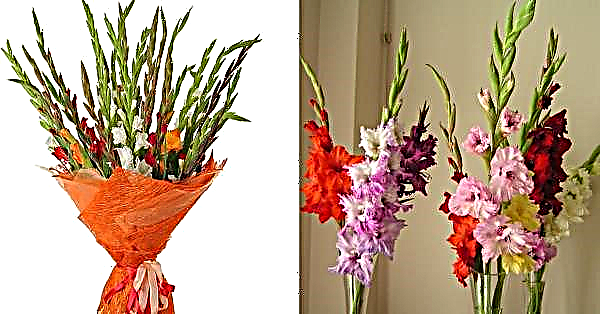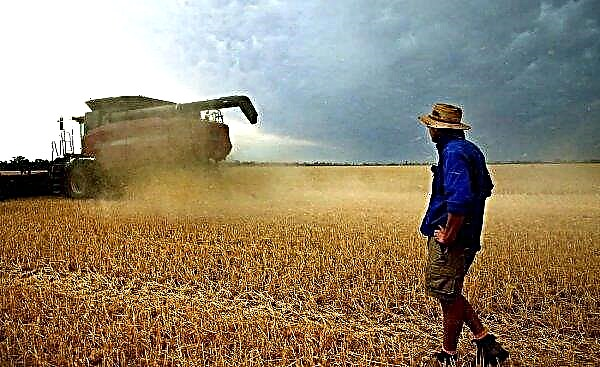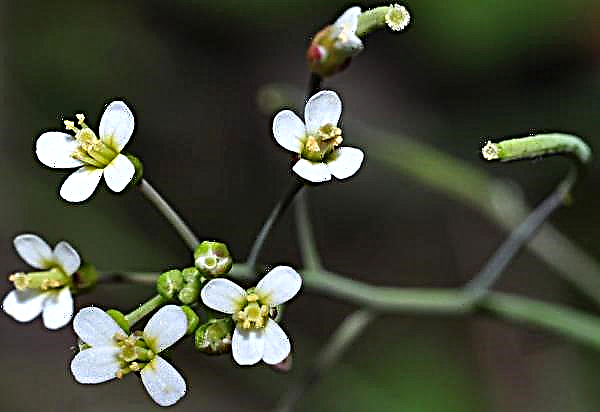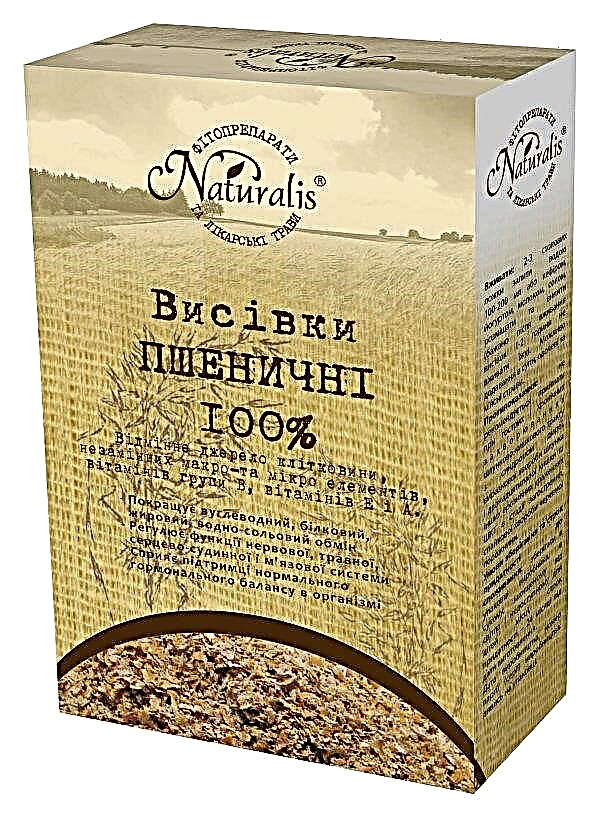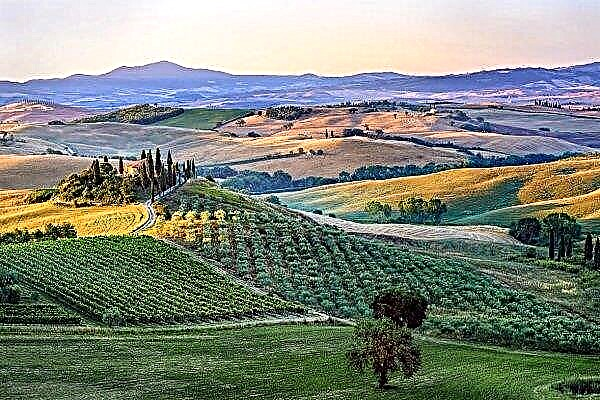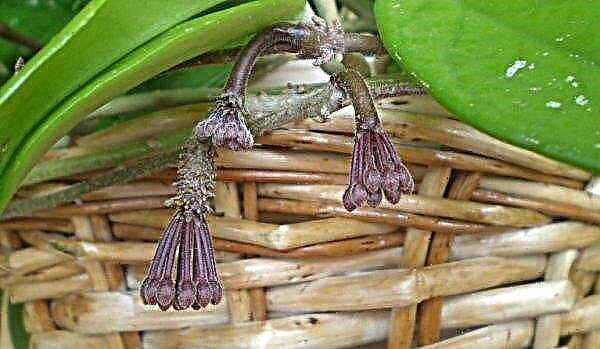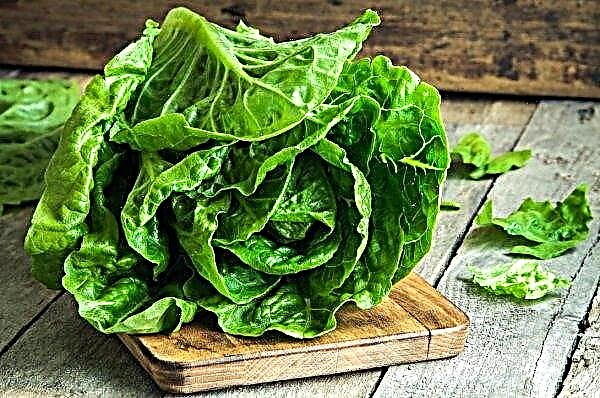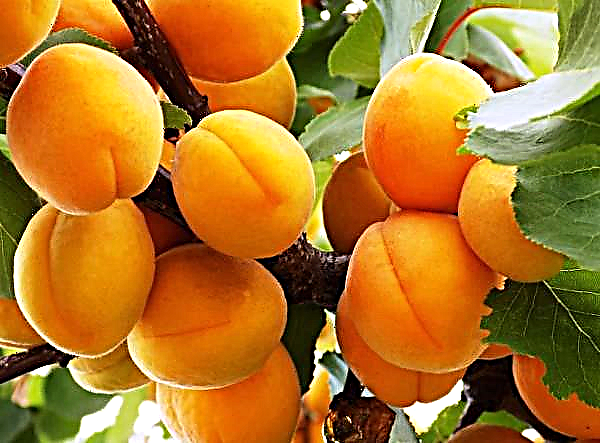Coniferous trees are good at any time of the year. Their greens attract attention, and their volatile produce healthier air. Thuja Golden Brabant is a yellow-bronze version of the traditional Brabant. You will find a detailed description of this decorative golden tree, as well as the conditions for planting and growing it in this article.
Botanical tree description
Western Thuja Brabant (Thuja occidentalis Brabant) - one of the best varieties. It is characterized as a fast-growing, compact, conical, evergreen coniferous tree with fragrant yellowish-green foliage. It is the result of the crossing of the thuja western and folded. Hence its high growth and resistance to any climatic conditions.

This tree is considered the first in terms of sales in European nurseries. The price of Brabant in British nurseries is only 19.9 pounds, which is much lower than the cost of a tree in Russian - from 9900 to 11 000 rubles. But if you decide to make a purchase, then note that annual seedlings are best accepted and their cost will be minimal.

Brabant is common in Russia since the days of the USSR. He was landed in children's educational institutions, hospitals and near office buildings. Thuja grow on average up to 100-150 years. But there are also older instances.
Did you know? When the cones of the western thuja open, they look like small roses.
Characteristics of the western thuja Brabant:
| Botanical name | Thuja western |
| Synonyms | Northern White Cedar, Eastern White Cedar |
| Family | Cupressaceae |
| A type | Evergreen conifer |
| Using | For decorating the territory, creating hedges, hedging |
| Lighting | Full sun (minimum 6 hours of sunshine per day) |
| Frost zone | 3–7 |
| The soil | Alkaline, moist, well-drained |
| Tolerance | It can tolerate short droughts and salty soil on the coast, also tolerates haircut |
| Problems | Breaks in a strong wind or snow |
Golden Brabant (T. Golden Brabant) is a type of ordinary Brabant. Its golden-it preserves the green shade of needles even in winter, which is becoming very popular among gardeners.
 The most important quality due to which the variety is so popular is its accelerated growth. Competition in matters of growth is only one larch.
The most important quality due to which the variety is so popular is its accelerated growth. Competition in matters of growth is only one larch.
Brabant himself, provided that he is not sheared, grows to 20 m. During the year, its branches are added up to 30 cm in length, and the plant's width increases by 10 cm. But in landscape design they prefer to use its more compact varieties.
Typical characteristics of the thuja Golden Brabant:
- Appearance. A single-stemmed tree with thick branches at the base of the trunk. It has a conical shape, but lends itself well to pruning. It can be almost any shape you choose for a haircut. It looks great both as a stand-alone tree, and as part of a group. But most often used to create hedges. Specialists in the design of the area are attracted by the yellow (gold) color of the needles.
 In winter, the crown will remain the same shade, provided that the tree is not weathered by frost and does not get sick, so the combination of golden needles and white snow is considered one of the most elegant winter compositions. If you want to make the tree more golden, just plant it in a sunny area.
In winter, the crown will remain the same shade, provided that the tree is not weathered by frost and does not get sick, so the combination of golden needles and white snow is considered one of the most elegant winter compositions. If you want to make the tree more golden, just plant it in a sunny area. - Bloom. In May, Golden Brabant will delight you with small attractive bumps. They have an oblong shape and a chocolate brown tinge of scales by the end of summer. The length of the cones do not exceed 1 cm.
- Root system. The root system of the plant is closed. It means that it can be transplanted year-round. But in order to reduce the number of risks, it is better to do this in the spring. Plants whose age exceeds 3 years are transplanted with all the soil that is in their planting container. Otherwise, a fungus called mycorrhiza can be harmed. This is a symbiont fungus that grows on the roots of conifers. The mushroom receives carbohydrates from the tree, which are formed during photosynthesis, in return providing it with useful substances from the soil. Without it, the tree will die.
Video: Thuja West Brabant
Origin of name
The variety was obtained in the early 1980s by H.J. van de Laarom in the Stinsel nursery, province of North Brabant (Netherlands). The nursery specializes in growing conifers of different species. New varieties are being introduced here today, trying to diversify the possibilities of gardeners for landscaping.
Landing
It will be nice if you plant thuja in a sunny area with fertile soil and good drainage. An important factor for its successful development will be the presence of moist, but not wet soil, as well as neutral or slightly alkaline soil. Dense will cause the development of fungi, which is unacceptable. But the soil should not be too loose, for example, sandy due to the fact that with a strong wind a tall tree will be tumbled down by the wind.
Important! Depth of planting depends on the growth of the tree. The higher it is and the greater its roots, the deeper the pit. At the same time, it is taken into account that the root neck should be located exactly at the same level at which the tree grew in the nursery.
Plan your landing at any time of the year. But Brabant is recommended to be planted in the spring. An important factor is air temperature. It should be at least + 5 ° C so that the roots can develop. In spring, this weather is set in mid-March, and with autumn landing in October.
Landing Rules:
- The landing area needs to be dug up.
- Dig a hole to a depth of 0.8 m. The higher the seedling, the deeper the hole should be dug. If a hedge is created, then first measure the size of the alley, then install one tree at its ends and evenly distribute the rest between them. Approximately between two thuja it will turn out at least 50 cm and no more than 2 m. If landing is carried out in 2 rows, then 0.5–0.7 m is left between them. It is advisable to leave no more than 8 m between two adjacent alleys.
- If the site is heavy clay soil, then it is necessary to create a drainage layer. It can be brick chips, pebbles or other materials. Layer thickness - 20 cm.
- Mix the soil removed from the pit with compost and sand, if it is dense.
- Lay part of the soil-soil at the bottom of the pit.
- Water the thuja seedling to make it easier to get out of the container. Loosen the soil on the sides of the pot and gently remove the seedling from it.
- Set the thuja in the center.
- Finish planting by filling the pit with soil and watering the planted tree abundantly.

The first month after planting is the most responsible. Water the seedling up to 3 times a week. During drought, water more often. After irrigation, it is required to regularly loosen the soil to a depth of not more than 10 centimeters, since the Brabant roots pass close to the surface and can be damaged. A layer of mulch up to 7 cm thick is laid on top of the soil. It will protect the soil from being compressed, and moisture from evaporation.
Video: Landing thuja
Thuja care
Conifers are undemanding in care, but this does not mean that they do not need care. Proper care will support the health of the plant and ensure its long life. And in return it will delight you with its excellent appearance.
Thuja care will include:
- regular watering;
- periodic fertilizer application;
- pruning
- pest and disease control;
- preparing the tree for wintering.
Watering and feeding
Brabant belongs to tall trees, so it can consume up to 100 liters of water per week. The distribution of watering over the seasons is uneven, but it should be borne in mind that the evergreens do not hibernate, which means that they need moisture even in winter. With its lack of needles can brown (dry) and crumble. An adult tree is watered as the soil dries. It is necessary to evenly distribute moisture throughout the root system. To do this, look at the tree. Visually draw a circle on the ground equal to the size of the lower branches. This is the root distribution zone.
An adult tree is watered as the soil dries. It is necessary to evenly distribute moisture throughout the root system. To do this, look at the tree. Visually draw a circle on the ground equal to the size of the lower branches. This is the root distribution zone.
To make watering more productive, some gardeners form a small ditch along this circle and pour water into it. As a result, more moisture gets into the soil in 1 irrigation than when the root zone is irrigated.
Important! Never pour water on the trunk. Excessive moisture can cause thuja to become infected with fungi.
Brabant belongs to the vigorous varieties. Its annual growth of branches can reach up to 30 cm, therefore, before fertilizing, measure it with a ruler. Normally developing tree do not fertilize. The first five years after planting, the seedling is developing intensively.
In the spring, he may need fertilizers, so you need to measure the nutrient content in the soil. This can be done in the laboratory or using special test equipment for the garden. If there are not enough substances in the soil, then you need to add them.
 You may need:
You may need:
- Enhanced dose of nitrogenif the growth of branches is insufficient. In this case, the chemical content in the fertilizer should be marked on the packaging as 10:30:10, where 30 is the percentage of nitrogen in the solution. That is how much of it is contained in ammonium nitrate. Norm: 30 g per 10 liters of water. The solution is enough for 2 trees.
- Potassium deficiency manifests itself in the form of spots on the needles and its fall. Replenish its reserves by making ash. To do this, 200 g is dissolved in 10 l of water and the root zone is watered.
- Phosphorus deficiency manifested in slowing plant growth and a bluish tint of needles. Replenish its reserves by introducing superphosphate. It will take 2 tbsp. spoons per 1 square. m square root zone.
Video: Fertilizers and preparations necessary for thuja
Loosening and mulching
Cultivation (loosening) poses a gardener 2 tasks: to remove weeds and optimize the penetration of air into the soil layers. Weeds consume moisture and nutrients from the soil, taking them from cultivated plants. Their removal reduces competition.
In addition, they become a convenient platform for the life of pests. As for air, soil bacteria need it, which process poorly digestible substances, such as phosphorus and those that can be absorbed by wood. Therefore, the penetration of air masses into the soil is also an important condition for plant health.
Did you know? Designers advise combining different types of arborvitae in an alley or hedge, for example, ordinary and golden Brabant. This gives her a more festive look.
Loosening soil deeper than 10 cm is not necessary. Below is the root system. Work is carried out the day after watering or when it is necessary to remove weeds. Every time after feeding, it is also advisable to loosen the soil and pour plenty of water. And although not all gardeners agree with the need, frequency, and depth of tillage, it is still common practice.
But if a layer of mulch is located in the basal zone, then there is no need to loosen it. This layer does not allow the soil to condense, inhibits the growth of weeds and evaporation of moisture. Choose organic mulch for thuja: wood chips, chopped straw or sawdust.
 Under the influence of irrigation water, the mulch will be crushed, giving nutrients to the plant, so from time to time it needs to be added.
Under the influence of irrigation water, the mulch will be crushed, giving nutrients to the plant, so from time to time it needs to be added.
Mulching rules:
- Position the mulch so that it spreads from the trunk to the end of the branch zone, but does not lie close to the trunk. The distance between them should be 15 cm.
- If straw is used, then the depth of the layer will be 6 cm; if it is bark or other lumpy material, then 14–15 cm.
- Do not place mowed grass under a tree, as its seeds or parts of the roots can sprout.
Pruning
If a hedge is created, they begin to trim it from the moment the seedlings are planted. To do this, visually draw a line along a row of trees. This is a conditional cut line.
The annual growth of Brabant is 20-30 cm. It is necessary to cut 5-10 cm of them. This molding trimming is carried out at the end of July, i.e., when the growth of the current growing season has ended.
Important! It is undesirable to cut trees in extreme heat, as this enhances the loss of moisture needles.
Another type of pruning is sanitary. It consists of removing dry and damaged branches. Perform it in late February or early March annually. And every three years they carry out rejuvenation. Pay attention to how the branch grows. At the end, young needles are formed.

The old one is located closer to the trunk and periodically it falls, so it is worth trimming the completely bare branches to stimulate the growth of new ones. Cut them preferably every 3 years. Too pruned are too elongated branches. They can break in the winter under the weight of the snow, so it is better to remove them.
Video: haircut western thuja Brabant
Possible diseases and pests
Like all plants, thuja can hurt, so you need to periodically inspect the trunk for modifications. If the color of the needles changes, spots or tarry discharge appear - these are signs of infection.
Did you know? One bark beetle eats 10 g of wood per day. These bugs can live not only in trees, but also in furniture that is made of these trees.
The main problems associated with the appearance of pests:
- Gray-silver dusting on the branches is aphids. They are too small and look like dust. Spend the tree processing "Fufanon." The composition of the solution: 10 mg per 10 l of water. The first spraying is carried out in May and after 10 days is repeated.

- Spider webs on needles are a sign of a spider mite. Treat the tree with colloidal sulfur or garlic infusion.
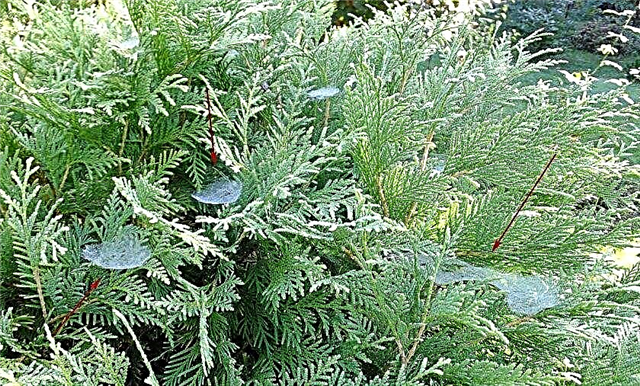
- If shoots turn yellow, then this is a sign of the appearance of scale insects. Spray "Karbofos" in several stages with an interval of 7 days. The same drug will help get rid of bugs.
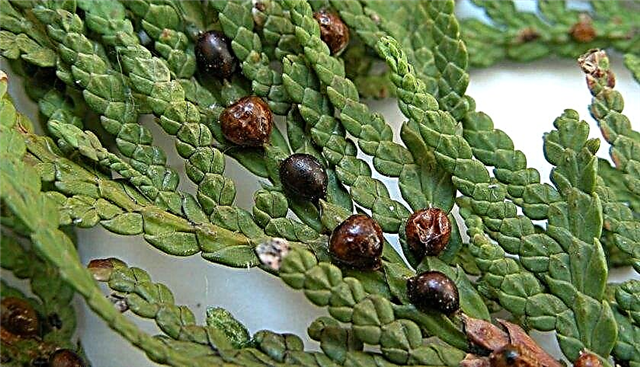
- Shoots turn brown - this is a sign of mottled moth. Branches change color because they dry. The pest gnaws at them, laying eggs. Butterflies are especially active in May. Having found the pest, spray with Cypermetrin. The substance must be strictly dosed according to the instructions. For a spider mite, you need 0.1% solution (1 ml of the active substance dissolved in 1 liter of water).

- Bark beetles can gnaw moves in branches. Use “BI-58”, “Clipper”, “Confidor”, “Bifentrin” or another drug against them.

If you notice the infection by insects in time, then the tree can be cured. This will prevent its weakening and infection of the rest of the alley. Weakened are more often exposed to both insects and phytopathogens, therefore, creating the right conditions for growing will help ensure that the tree is less likely to be attacked by insects and bacteria.
Thuja is resistant to diseases, but high humidity leads to their appearance. Poor air circulation in the crown also contributes to this.
More often than other gardeners mention the following diseases:
- Late blight. The disease begins to spread from the soil and damages the roots. Then the fungus moves along the trunk, and the lower part of the trunk begins to rot. The bark darkens, the needles fade and crumble. The cause of infection is excessive watering. In order to prevent the occurrence of the disease, treat the soil with Rovral Flo 255 SC. If the disease is in an irreversible stage, then the tree is dug up and burned. Thuja - one of the most resistant to rotting trees. And if the rot of the trunk appeared, then nothing can be done with this.
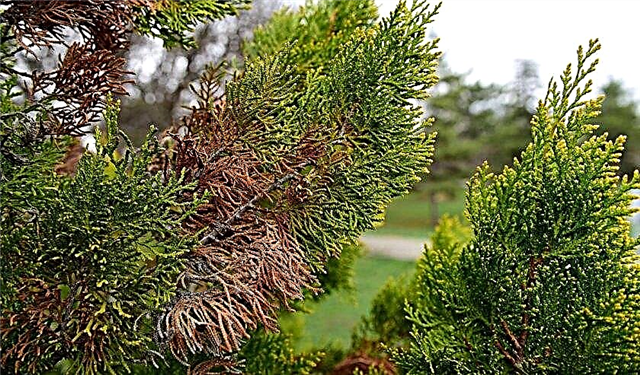
- Fusarium arises from a lack of sun. To avoid the disease, drugs are added to the soil that contain copper and iron. For example, a 0.2% solution of Fundazole.

- Rust - a fungal disease that appears on the needles in the form of characteristic spots.For treatment, the soil is treated with Fundazol, and the tree itself is sprayed with a solution of copper sulfate 0.5%.

The use of wood in landscape design
Thuja can be planted in the form of individual trees or in a group composition: alley, hedge. Brabant is often used in group plantings. They are decorated with parks, squares and territories in front of buildings. It will fit into any style, but more often it is English classic. This style appeared at the beginning of the XVIII century.

It provides for the formation of a special, geometrically correct composition around the building. When designing, trimmed shrubs, geometrically regular tree crowns should be used. Thuja hedges are one of the essential elements of such a design.

Tui do not only create a visual barrier. They are able to reduce the noise of the freeway, dust entering your garden. Its phytoncides heal the air, reducing the number of viruses and bacteria in it. Fallen needles can be used as mulch in the beds, and fresh needles to brew in the form of tea. The Indians of America brewed it for the treatment of colds.
Brabant belongs to frost-resistant varieties, so it can be grown in any corner of Russia. For its successful growth, it is enough to know a number of requirements for soil, water and lighting. In addition, this is the most famous variety in landscape design.

 In winter, the crown will remain the same shade, provided that the tree is not weathered by frost and does not get sick, so the combination of golden needles and white snow is considered one of the most elegant winter compositions. If you want to make the tree more golden, just plant it in a sunny area.
In winter, the crown will remain the same shade, provided that the tree is not weathered by frost and does not get sick, so the combination of golden needles and white snow is considered one of the most elegant winter compositions. If you want to make the tree more golden, just plant it in a sunny area.







